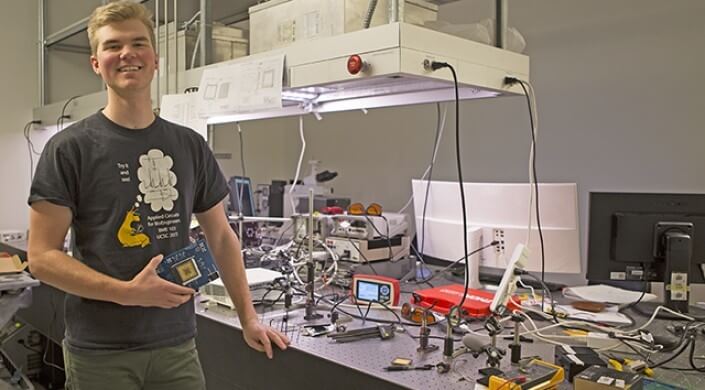News
Graduate student Henry Hinton was honored by Analog Devices with the 2019 Outstanding Student Designer Award. (Photo by Adam Zewe/SEAS Communications)
Graduate student Henry Hinton has been selected by Analog Devices (ADI) to receive the 2019 Outstanding Student Designer Award.
The award, presented annually by ADI since 1997, recognizes excellence in system-level integrated circuit architectures or in analog, mixed-signal, or digital integrated circuit design. Hinton was nominated by his advisor, Donhee Ham, Gordon McKay Professor of Electrical Engineering and Applied Physics, for his work developing highly efficient peripheral external circuit boards (PCBs) that measure the voltage characteristics of a dense array of active devices made out of novel, “2D” materials.
“Since he arrived at Harvard last semester, Henry has been working on precision measurement systems for our ‘2D’ material device arrays. His design done during this short period of time is a paragon of excellence, and has crucially accelerated our measurement of the complex ‘2D’ array with unusual device properties,” Ham said. “I am greatly looking forward to working with Henry on his main project on neuro-electronic interfaces.”
Hinton, who earned a bachelor’s degree in bioengineering: bioelectronics from the University of California, Santa Cruz, is a first-year electrical engineering Ph.D. candidate at the Harvard John A. Paulson School of Engineering and Applied Science and Graduate School of Arts and Sciences.
At SEAS, Hinton and his colleagues work with molybdenum disulfide (MoS2) monolayers, an atomically thin “2D” material, that responds to optical and electrical stimulation in unique ways. But testing an array of transistors made from this material was difficult, since an off-the-shelf measurement unit could take 10 minutes to capture a single data point. Capturing the hundreds of points required to fully assess the devices would take an impractically long time, Hinton explained.
The PCBs Hinton develops can conduct current and voltage (I-V) measurements for the whole array in about two seconds, and record a full I-V sweep in about 15 minutes.
“There are a lot of different parameters that we are investigating right now, so having these precision testing devices enables us to characterize the material for its full operating range,” he said. “Although MoS2 can be very optically sensitive, the change in current might still be less than a nanoamp for some appreciable change in the light output. Being able to see those signals in the first place takes a lot of engineering.”
To measure these minute outputs, a precision testing device must be extremely sensitive. Environmental factors, such as noise from power lines or even someone walking near the device, can throw off the current measurements, he said. Careful design compensates for these noise sources.
“Producing these devices in the first place is a really intensive process because the materials we are using are small—and really thin—so even the smallest amount of dust can destroy a device,” Hinton said. “Working in the clean room is challenging, but very interesting at the same time.”
This research is a departure from the bioengineering work Hinton did at UCSC, where he developed electronic interfaces to pick up signals from his lab’s research into pluripotent stem cell growth.
Hinton, a Stanford, Calif., native, decided to pursue a Ph.D. at SEAS so he could collaborate with researchers from different disciplines.
He looks forward to learning as much as he can as he delves deeper into research. Ultimately, Hinton hopes to apply his skills to a career in academia, where he could combine his interest in teaching with his passion for discovering new things.
“In research, the end goal is at some indeterminate point of time. The question itself may not be completely defined, and the answer is certainly not defined. That is where the real challenge is—trying to come up with some kind of intermediate process when the end result might be completely unknown to you,” he said. “I really enjoy that aspect of it.”
Topics: Awards, Electrical Engineering
Cutting-edge science delivered direct to your inbox.
Join the Harvard SEAS mailing list.
Scientist Profiles
Donhee Ham
John A. and Elizabeth S. Armstrong Professor of Engineering and Applied Sciences
Press Contact
Adam Zewe | 617-496-5878 | azewe@seas.harvard.edu




